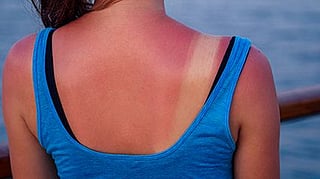Preventing a sunburn involves taking proactive measures to protect your skin from excessive UV radiation exposure.
Here are some effective strategies for sunburn prevention:
Use sunscreen
Apply a broad-spectrum sunscreen with UVA and UVB protection and with a Sun Protection Factor (SPF) of 30 or higher to all exposed skin — including your face, neck, ears and hands — at least 20-30 minutes before going outside, and reapply at least every 2 hours. Reapply frequently, and opt for a water-resistant sunscreen if you’re sweating or swimming. Sunscreens are available in various formulations, including lotions, creams, gels, sprays and sticks. Choose a formulation that suits your preferences and activities.
Are spray sunscreens effective?
Spray sunscreens can provide coverage from UV rays when used correctly. To ensure adequate coverage, the sunscreen needs to be applied evenly to avoid skipped areas. Spraying sunscreen on the hands and then applying on the skin ensures even coverage.
Protect your lips
Apply a lip balm with SPF to protect your lips from sunburn and UV damage.
Wear protective clothing
Covering up your skin with long-sleeved shirts, pants and wide-brimmed hats can provide additional protection from the sun's harmful UV rays. When choosing clothing for sun protection, look for garments made from tightly woven fabrics with a high Ultraviolet Protection Factor (UPF).
Wear sunglasses
Protect your eyes and eyelids by wearing sunglasses with UV protection. Not all sunglasses have UV protection, so be sure to check the label.
Seek shade
If possible, limit direct sun exposure, especially during peak UV radiation hours between 10 a.m. and 2 p.m. If you're outdoors, seek shade under trees, umbrellas or canopies to reduce your UV exposure.
Be mindful of reflections
Remember that UV rays can reflect off surfaces like water, sand, snow and concrete, increasing your exposure. Take extra precautions in these environments by applying sunscreen more frequently and wearing protective clothing.
Avoid tanning beds
Avoid using tanning beds, as they emit harmful UV radiation that can increase your risk of sunburn, skin aging and skin cancer.
Be consistent
Make sun protection a habit year-round, not just during the summer or on sunny days. UV radiation can penetrate clouds and cause sunburn even on overcast days.


